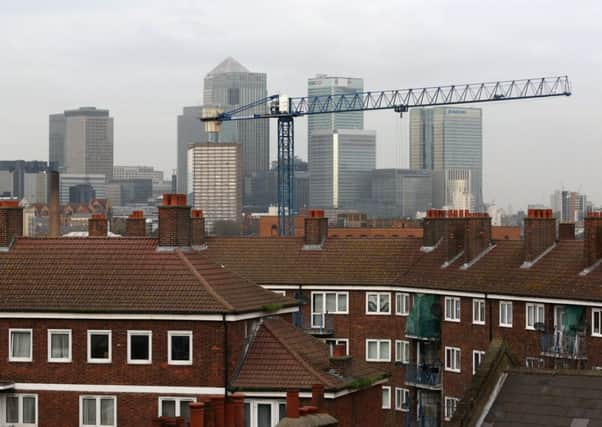Comment: Home buyers caught in mortgage trap


We have a problem with interest rates. In fact, we have two, and they are growing. The first will be familiar to households and businesses in Scotland: the difficulties posed by a “one size fits all” interest rate regime across the nations and regions of the UK when conditions on the ground can be markedly different.
We are experiencing just such a divergence now. Talk of a house price bubble has brought growing pressure on the Bank of England to raise interest rates to cool the housing market.
Advertisement
Hide AdAdvertisement
Hide AdIt is certainly true that some areas of London and the south-east are experiencing a worrying pace of house price inflation. House prices in London have risen by an average of 18 per cent in the past year. But that is not the case in Scotland, where prices have risen by a more modest 3.5 to 4 per cent, nor indeed for most of the UK, where house prices have risen by an average of around 9 per cent in the past 12 months. Indeed, in many parts of the UK, prices have still to recover to their pre-2007 level.
There is a second, bigger problem. This is the growing realisation that millions of households may now be trapped in an unsustainable, artificial world of ultra-cheap borrowing and mortgage rates.
The lowest level of interest rates for 350 years has now lasted so long – far longer than originally expected five years ago – that this emergency rate has become the new normal. Interest rate rises now are likely to prove far more traumatic and painful than in any recent period of monetary tightening.
And this in turn is part of the bigger problem, here and in the US, of how to exit the emergency regime of Quantitative Easing. The resort to money creation, universally hailed when introduced, is now proving an extremely difficult world from which to exit. Millions of households have taken on borrowing commitments that are only sustainable as long as the ultra-low levels of interest rates persist.
This dilemma has been compounded by the UK government’s Help to Buy scheme, which has pumped in £12 billion in guarantees to subsidise house purchases. This has enabled tens of thousands of households to take on lending commitments which could prove explosive when the interest rate cycle turns.
We are now close to that point, to judge by conflicting signals from the Bank of England last week. Governor Mark Carney said he would not raise interest rates to cool the housing market, but nevertheless indicated that a rise from the 0.5 per cent level is likely some time in the course of next year. Most commentators still believe this will come in the early summer – close to the Westminster general election next May.
Clearly, something is now seriously wrong with Britain’s housing market when the government is supplying a substantial volume of subsidy support and policy-makers are increasingly concerned about the need to cool a house price bubble. A bubble can hardly be said to persist across large parts of the UK, and yet the price of a house as a multiple of average income is historically high.
Economist Richard Batley of Lombard Street Research has captured the dilemma well in a recent note. Housing can be affordable either because prices are low relative to household incomes or because debt service payments are low relative to incomes. Clearly the first condition doesn’t apply. The average house price is 4.3 times average household income compared with a 50-year average of just 3.4 times. House prices on this measure are historically high. But the second condition certainly applies. The average first year debt service for a 95 per cent mortgage on an average house would take up just 28 per cent of an average household’s income – compared with a 50-year average of almost 50 per cent. So here is the dilemma in a nutshell: historically, houses are expensive – but debt to buy them is extremely cheap.
Advertisement
Hide AdAdvertisement
Hide AdThe result is that overall house price affordability has become very sensitive to changes in interest rates. The fact, says Batley, that UK mortgages are almost entirely at variable rates, or very short-term fixed rates, means the housing market is benefitting from what is effectively a Bank of England-imposed “teaser rate”.
Now, with a turn in the interest rate cycle on the horizon, the vulnerability of housing affordability to small changes in interest rates will become apparent. This, Batley points out, need not spark an aggregate problem for banks in terms of overall loan defaults – the capital that the banks have set aside against UK residential mortgages has trebled since 2008, so the banking system “is now well equipped to fight the last war”. Nor can house prices be said to be on the brink of collapse.
“But the reality is that current house price valuations depend on first-time buyers taking out mortgages at loan-to-income ratios that are well above their historic average and have only ever been surpassed – unsustainably so – during the three years before the financial crisis.
“As interest rates increase, these first time buyers will need more help, not less. This could eventually come in the form of real-term declines in house prices, but in the meantime the temptation will be to use government programmes like Help to Buy – already extended to the end of the decade – to subsidise first-time buyer loans.”
And it is this extreme interest rate sensitivity of the UK housing market that could make the Help to Buy scheme a far more enduring feature than so far realised. Batley’s reminder of that tart quip by former US president Ronald Reagan neatly captures the trap we’re in: “Nothing lasts longer than a temporary government programme.” «